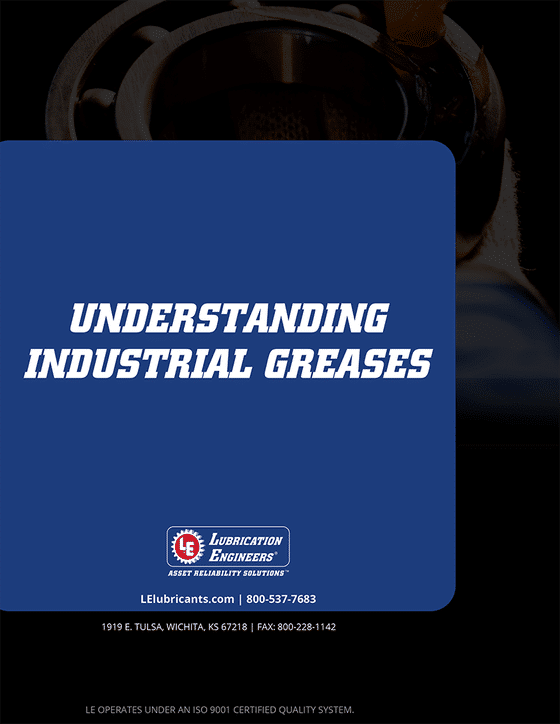Lubrication Engineers, Inc. (LE) is a leading developer and manufacturer of industrial greases. This blog is an overview of our eBook, which delves into the types, characteristics, functionality and applications of industrial greases.
Understanding Industrial Greases
Proper lubrication of equipment is essential for efficient and cost-effective industrial operations. Industrial grease is a semi-solid lubricant consisting of base fluid, thickener and additives. The base fluid and additives are often considered the most important parts of industrial grease formulations because they affect the grease’s lubricating characteristics. The thickener holds the base oil and additives in place in applications where fluid lubricant would run right out.
Functionality of Grease
Grease provides lubrication between moving, contacting surfaces without leaking or losing lubricity under the force of centrifugal action, gravity or pressure. It acts as a sealant to keep out contaminants and foreign substances, minimize lubricant leakage, and prevent corrosion. When there is a desire to include solid lubricants, such as very heavily loaded applications, the thickened grease keeps them in suspension whereas they could settle out of a fluid lubricant before reaching the lubricated contact. Grease’s rigidity allows for easier containment than oil, with simpler, less expensive retention devices.
Choosing the Right Grease
Industrial greases are often recommended for specific applications through an evaluation of various physical and chemical characteristics. Some of the important characteristics include:
- Thickener: Soap-thickened greases are by far the most used. Different soaps can provide specific benefits in thickening efficiency, shear stability and compatibility with additives, base fluids and other greases they might be mixed with.
- Base Fluid: Grease often contains one or several base fluids mixed in a ratio to adjust the base fluid to a desired viscosity.
- Additives: Ingredients are added to grease to impart additional performance properties, such as extreme pressure, anti-wear, corrosion resistance, oxidation resistance, and tackiness. LE developed proprietary additives for exclusive use in its lubricants.
All grease ingredients, properly dispersed, affect the following characteristics:
- Pumpability: A measure of how easily it is pushed into a mechanical device.
- Consistency: Ability to resist deformation due to an applied force.
- Water resistance: Determines how susceptible its properties are to change when exposed to water.
- Oxidation stability: Grease’s ability to resist reacting with oxygen. Oxidation typically causes sludge or lacquer-like deposits in equipment, which can slow operation and increase friction and wear.
- Dropping point: Indicates a grease’s heat resistance.
- Low-temperature effects: Typically, the base oil’s pour point provides a guideline for the low-temperature limit of most industrial greases.
High-temperature effects: Because grease is semi-solid, it cannot dissipate heat by convection like fluid lubricants. High temperatures can damage the thickener structure of the grease, allowing it to soften and possibly flow out of the application.
Lubrication Engineers works with companies all over the world to create customized lubrication reliability programs using top-of-the-line grease formulations. Offering a full line of high-performance industrial greases, LE provides proven lubrication solutions for many industries. To learn more about industrial greases and their common applications, please download our eBook: Understanding Industrial Greases


 Download Now
Download Now